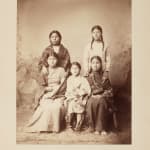[Hampton Institute]
Trio of Photos Showing Native Americans Students Upon Arrival at the School, c. 1881
Albumen prints (3)
Each approximately 9 x 7 inches, mounts larger
With manuscript notations mount recto.
With manuscript notations mount recto.
Sold
Further images
The first photograph shows several young girls of the Hunkpapa group, one of the seven tribal fires of the Lakota tribe, who were relocated to Hampton from the Standing Rock...
The first photograph shows several young girls of the Hunkpapa group, one of the seven tribal fires of the Lakota tribe, who were relocated to Hampton from the Standing Rock Reservation. They are identified on the mount as Rose Bear Face, Josy McCarthy, Fidelia Walking Medicine, Walking Holy, and Francis Gray Cow. Rose Bear Face later taught at Hampton and Francis Gray Cow (identified as Francis White Cow elsewhere) went on to assist her. Josephine McCarthy, later Josephine Waggoner, became a Hunkpapa historian. In the 1930s, she authored the memoir “"With My Own Eyes: A Lakota Woman Tells Her People's History" though it would not be published until 2013.
The second photograph also shows arrivals from Standing Rock, identified on the mount as Baptiste Gabe and “J. Marsh” (most likely Joseph Marsh). The third name reads only “Larrabees.” This most likely refers to William Larrabee and his younger sister, Maggie. The third photograph shows two girls from the Gros Ventres tribe, identified on the mount Mary Walker and Susie Nagle. According to the 1891 Senate report on Hampton, which mentions all of the present subjects, Nagle returned home after Hampton to work for her father at Fort Berthold.
One of the earliest schools that admitted Indigenous students is Hampton Agricultural and Industrial School, now known as Hampton University. Founded in 1868, Hampton is a historically Black college that was established by General Samuel Armstrong. The annexation of Native American land was followed by the displacement of tribes from their territories and the US government’s suppression of Indigenous heritage through forced cultural acclimation. Subsequently, Indigenous families were taken apart and their children were put into boarding schools such as Hampton. A 19th century compulsory attendance law empowered the Commissioner of Indian Affairs to withhold food, clothing and annuities from families who refused to send children to the government-run schools.
The Native American program at Hampton began in 1878 to provide a re-education for Native American prisoners of war but continued with regular enrollment until its termination in 1923. Armstrong intended for a cultural exchange where the Indigenous would “uplift” the Black students by inspiring a sense of nationhood and the Black students could “civilize” the Indigenous through assimilation. While the program was considered a success at the time and led to the opening of another Indian boarding school, the ideas of “civilizing” and “uplifting” were always condemned by the affected parties and the program lost popularity, and thus, funding, with segregation policies. While the program ended in 1923, Indigenous students continued to enroll when Hampton transitioned into a college and in 1991, the American Indian Education Opportunities Program was created through a federal grant to aid the legacy of Native American education at the school.
The second photograph also shows arrivals from Standing Rock, identified on the mount as Baptiste Gabe and “J. Marsh” (most likely Joseph Marsh). The third name reads only “Larrabees.” This most likely refers to William Larrabee and his younger sister, Maggie. The third photograph shows two girls from the Gros Ventres tribe, identified on the mount Mary Walker and Susie Nagle. According to the 1891 Senate report on Hampton, which mentions all of the present subjects, Nagle returned home after Hampton to work for her father at Fort Berthold.
One of the earliest schools that admitted Indigenous students is Hampton Agricultural and Industrial School, now known as Hampton University. Founded in 1868, Hampton is a historically Black college that was established by General Samuel Armstrong. The annexation of Native American land was followed by the displacement of tribes from their territories and the US government’s suppression of Indigenous heritage through forced cultural acclimation. Subsequently, Indigenous families were taken apart and their children were put into boarding schools such as Hampton. A 19th century compulsory attendance law empowered the Commissioner of Indian Affairs to withhold food, clothing and annuities from families who refused to send children to the government-run schools.
The Native American program at Hampton began in 1878 to provide a re-education for Native American prisoners of war but continued with regular enrollment until its termination in 1923. Armstrong intended for a cultural exchange where the Indigenous would “uplift” the Black students by inspiring a sense of nationhood and the Black students could “civilize” the Indigenous through assimilation. While the program was considered a success at the time and led to the opening of another Indian boarding school, the ideas of “civilizing” and “uplifting” were always condemned by the affected parties and the program lost popularity, and thus, funding, with segregation policies. While the program ended in 1923, Indigenous students continued to enroll when Hampton transitioned into a college and in 1991, the American Indian Education Opportunities Program was created through a federal grant to aid the legacy of Native American education at the school.
![[Hampton Institute], Trio of Photos Showing Native Americans Students Upon Arrival at the School, c. 1881](https://artlogic-res.cloudinary.com/w_1600,h_1600,c_limit,f_auto,fl_lossy,q_auto/artlogicstorage/dollc/images/view/4def29558dbb7475ab7a7444d1690ea7j/daniel-oliver-hampton-institute-trio-of-photos-showing-native-americans-students-upon-arrival-at-the-school-c.-1881.jpg)
![[Hampton Institute], Trio of Photos Showing Native Americans Students Upon Arrival at the School, c. 1881](https://artlogic-res.cloudinary.com/w_1600,h_1600,c_limit,f_auto,fl_lossy,q_auto/artlogicstorage/dollc/images/view/46895d4245b74a7223f41c59220235f6j/daniel-oliver-hampton-institute-trio-of-photos-showing-native-americans-students-upon-arrival-at-the-school-c.-1881.jpg)
![[Hampton Institute], Trio of Photos Showing Native Americans Students Upon Arrival at the School, c. 1881](https://artlogic-res.cloudinary.com/w_1600,h_1600,c_limit,f_auto,fl_lossy,q_auto/artlogicstorage/dollc/images/view/c69df4fefdb1922d4faef714962bb183j/daniel-oliver-hampton-institute-trio-of-photos-showing-native-americans-students-upon-arrival-at-the-school-c.-1881.jpg)


